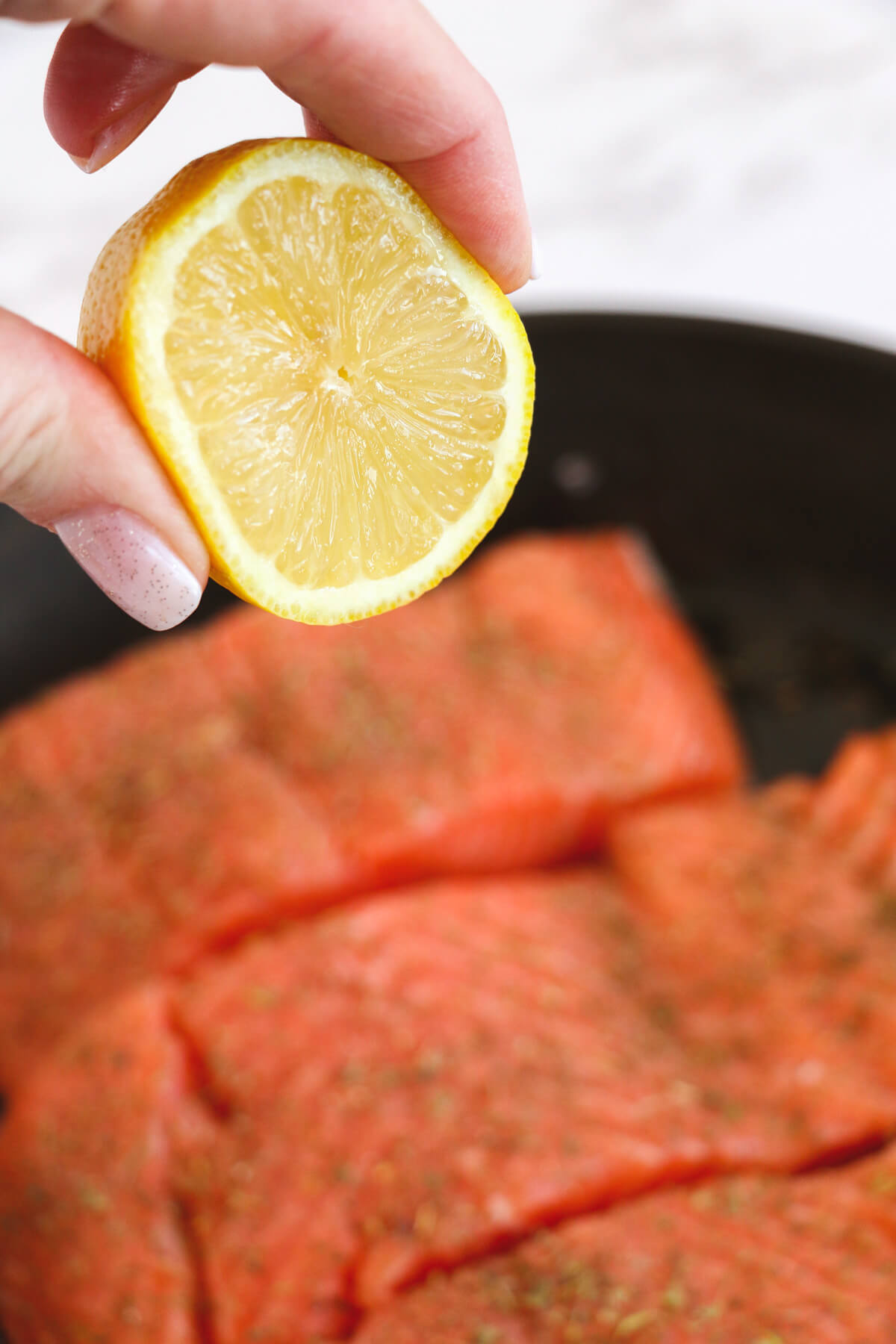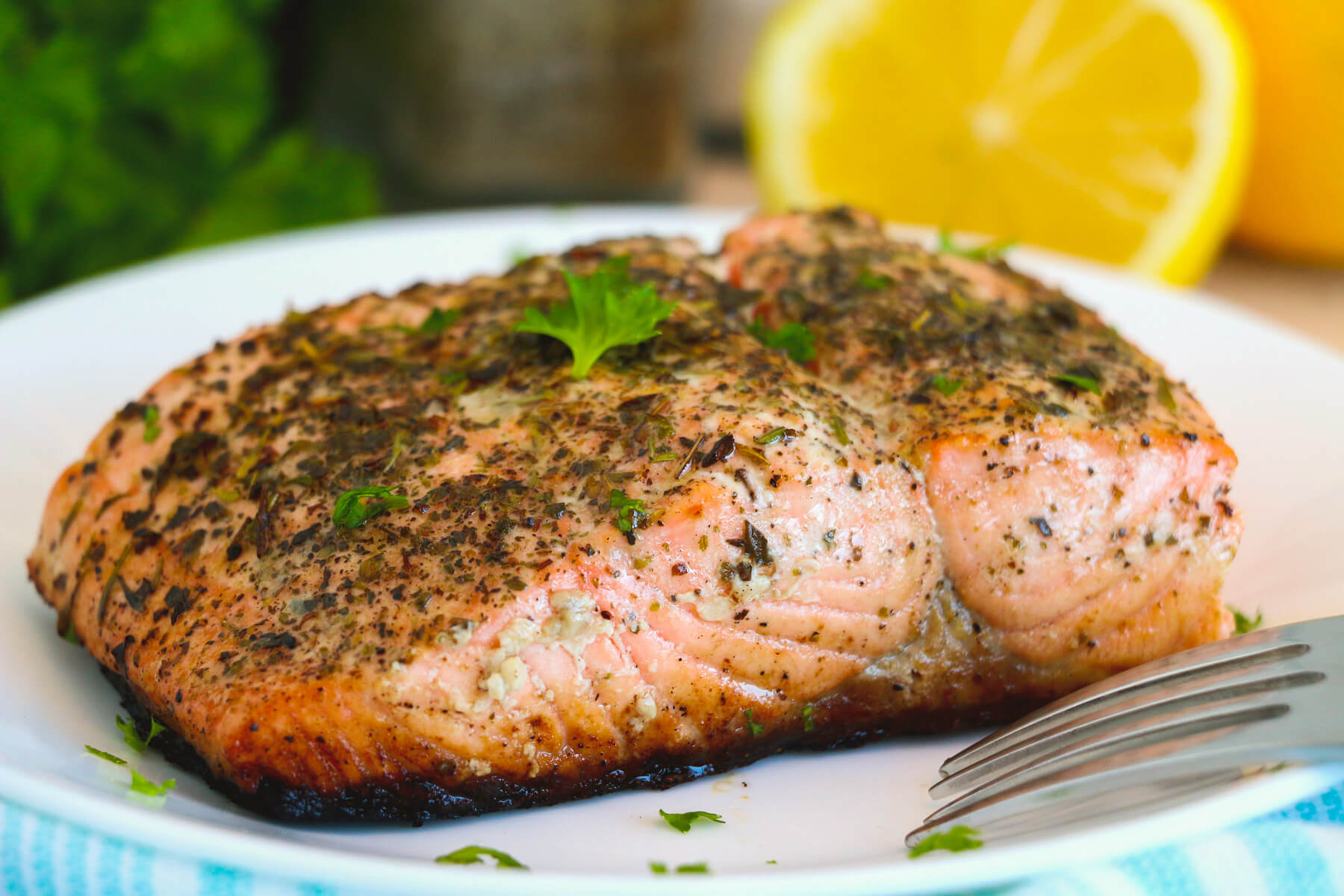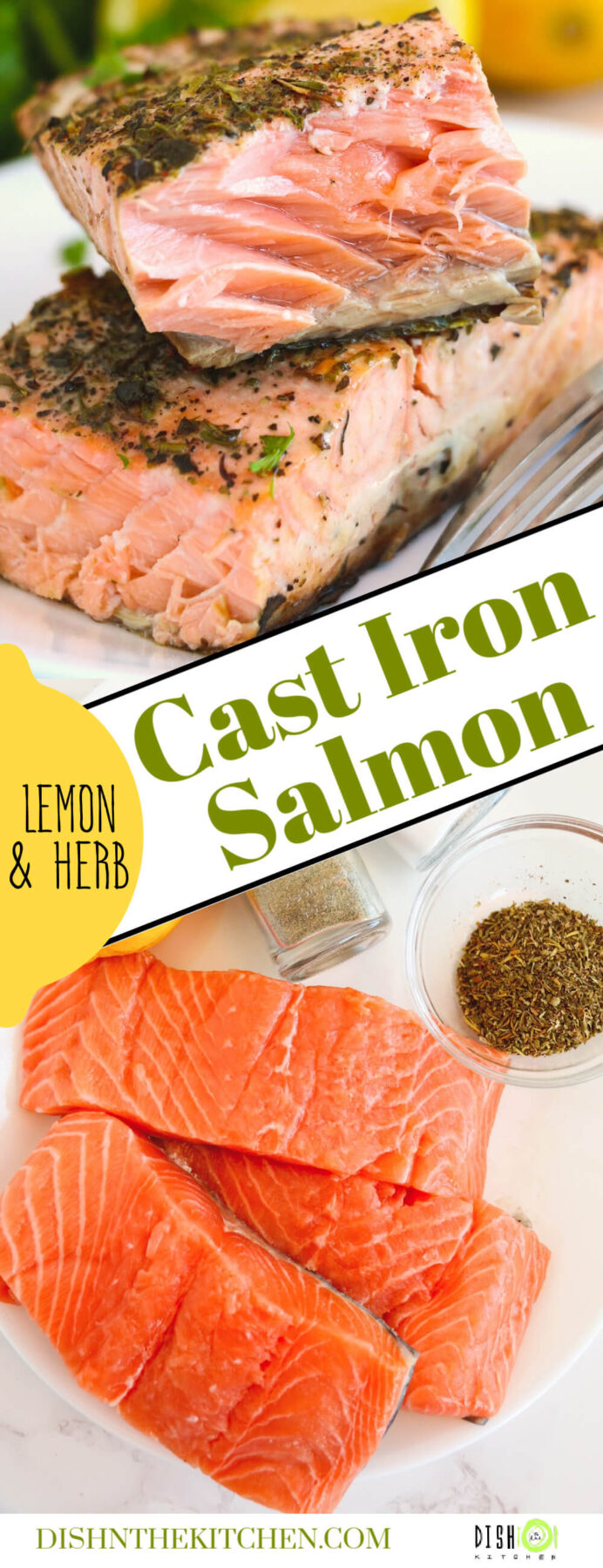This Cast Iron Salmon recipe has all the helpful tips you need to always cook a salmon fillet with skin on it. It’s an easy, healthy weeknight dinner option you can make in around ten minutes.
Do you have time to make a healthy dinner during the week? Of course you do! Check out the other quick and easy weeknight dinners on the blog. As a starter, here are my 30 minute Teriyaki Beef Sticks recipe and my 30 minute Easy Chicken Caprese recipe for the air fryer.
Salmon is one of the most popular and nutritious fish you can eat It’s rich in heart-healthy omega-3 fatty acids, high in protein, and a great source of important nutrients like vitamin B12, selenium, and potassium
Cooking salmon can seem intimidating, but it doesn’t have to be! One of the easiest and most foolproof ways to prepare salmon is to cook it in a cast iron skillet The cast iron helps create a crisp, flavorful crust while keeping the inside moist and tender.
In this article, I’ll walk you through everything you need to know to make perfect cast iron salmon at home. We’ll cover:
- Benefits of Cooking Salmon in Cast Iron
- Choosing the Right Salmon
- Ingredients to Have on Hand
- Step-by-Step Instructions
- Helpful Tips and Tricks
- Serving Suggestions
- Storing Leftovers
By the end, you’ll feel confident cooking delicious, restaurant-quality salmon in your own kitchen using this easy cast iron method. Let’s get started!
Benefits of Cooking Salmon in Cast Iron
There are a few reasons why cast iron is ideal for cooking salmon:
-
Even heating: Cast iron skillets heat very evenly, preventing cold or hot spots that can lead to over or undercooked salmon.
-
Searing capabilities: Cast iron can get ripping hot, allowing you to develop a crispy, flavorful sear on the salmon skin.
-
Heat retention: Even after removing from heat, cast iron retains temperature well to continue cooking the salmon gently.
-
Nonstick surface: Cast iron that has been used for a long time naturally develops a nonstick patina that is great for salmon and other delicate fish.
-
Fast cooking: The salmon cooks quickly and stays moist and tender thanks to the heat-conducting properties of cast iron.
Simply put, cast iron is the perfect vessel for cooking salmon with an unbeatable crust and moist interior every time.
Choosing the Right Salmon
When it comes to salmon, wild-caught Alaskan salmon is generally considered superior in flavor and texture compared to farmed Atlantic salmon. It has a deeper orange-red color and higher healthy omega-3 levels as well.
However, responsibly-raised farmed salmon can still be a good option too. Talk to your local fishmonger about sustainability practices if going the farmed route.
For cast iron cooking, choose salmon fillets that are evenly thick throughout. Skin-on fillets are ideal to achieve crispy salmon skin in the skillet. Fillets that are 1 to 1 1/2 inches thick work well to cook through without drying out.
Finally, make sure your salmon looks and smells fresh before cooking. The color should be vibrant and the texture should be firm. There should be little to no fishy odor.
Ingredients to Have On Hand
Cooking salmon in cast iron requires very few ingredients:
- Salmon fillets
- Oil – olive, avocado, vegetable, etc.
- Salt and pepper
- Butter (optional)
- Fresh herbs like dill, thyme, rosemary (optional)
- Lemon wedges for serving
That’s really all you need for the basic recipe. Feel free to get creative and add other seasonings or aromatics as desired.
Step-by-Step Instructions
Follow these simple steps for flawless cast iron salmon every time.
1. Heat the Cast Iron Skillet
Start by heating your cast iron skillet over medium-high heat until very hot. The pan should be fully preheated before adding the oil and salmon.
2. Pat Salmon Dry and Season
While the skillet heats, pat the salmon fillets dry with paper towels. Then brush lightly with oil and season both sides with salt and pepper.
Drying the salmon helps ensure a nice sear, while the oil prevents sticking. Season generously with salt and pepper.
3. Add Oil and Salmon Skin-Side Down
Once the skillet is hot, add just enough oil to coat the bottom, about 1 tsp. Swirl to coat evenly.
Carefully lay the salmon fillets in skin-side down. Resist the urge to move them once they’re in.
4. Sear Skin Side Then Flip and Cook Through
Let the salmon sear undisturbed until the skin is crisp and golden brown, about 3-5 minutes.
When ready, carefully flip the fillets over using a thin spatula. Cook until just opaque in center, about 2-3 minutes longer.
5. Optionally Make a Pan Sauce
Once cooked, transfer salmon to a plate and tent with foil to keep warm.
For a quick pan sauce, add butter, herbs, lemon juice and/or wine to the skillet and boil until thickened. Spoon over salmon.
6. Serve and Enjoy!
Plate your gorgeous cast iron salmon! Add any pan sauce, lemon wedges, fresh herbs, or other accompaniments.
Dig in and enjoy your restaurant-quality salmon, easily cooked right in your own kitchen.
Helpful Tips and Tricks
Here are some handy tips to ensure salmon success:
-
Let salmon sit at room temperature for 15-30 minutes before cooking for more even cooking.
-
Make sure salmon skin is very dry before searing to get it uber crispy.
-
Use a thinner spatula to gently flip salmon halfway through cooking to avoid tearing.
-
Use a meat thermometer to check for doneness; aim for 125°F for medium-rare.
-
Add fresh thyme, rosemary or dill sprigs to the hot pan to infuse flavors.
-
Make a quick compound butter by mixing softened butter with lemon zest, herbs and garlic.
-
Add a splash of white wine or lemon juice to the pan for a quick sauce.
Serving Suggestions
Pan seared cast iron salmon is delicious all on its own, but here are some tasty ways to serve it:
- On a bed of spinach, kale or arugula for a salad
- With roasted asparagus or green beans
- Over fresh pasta with pesto or tomato sauce
- On top of lemon quinoa or cauliflower rice
- In a whole wheat pita with tahini sauce and vegetables
- Alongside wild rice pilaf or herbed couscous
- On mixed greens with avocado and goddess dressing
You really can’t go wrong when pairing this omega-3 rich salmon with crisp veggies and whole grains.
Storing Leftovers
Here are some tips for storing leftover salmon:
-
Allow salmon to cool before transferring to an airtight container.
-
Store in the refrigerator for 2-3 days.
-
Can be frozen for up to 3 months; thaw overnight in fridge before using.
-
To reheat, place in baking dish, drizzle with oil or sauce and warm at 325°F until heated through.
With proper storage, you can enjoy leftover cast iron salmon in salads, sandwiches, tacos and more all week long!
Conclusion
Cooking delicious salmon in a cast iron skillet is easy and foolproof. With the cast iron’s even heating, searing capability and nonstick surface, you are guaranteed moist, flaky salmon with a crispy crust in minutes.
Use wild-caught salmon when possible and make sure fish is dry before searing. Cook skin side down first to get it crispy before flipping briefly to finish.
Then all that’s left is to plate your beautiful salmon fillets and add desired sauces or sides. This simple yet impressive salmon dinner can be a lifesaver for busy weeknights.
:max_bytes(150000):strip_icc()/8921374-37a66d18624f4cfa89e5e67a508de11c.jpg)
How to Choose Salmon Fillets
Firstly, give the fish the sniff test. Go on, follow your nose. The fish should smell only faintly fishy or salty sweet like the ocean, and nothing more. If it is overly fishy, give it a pass.
You can also give it a poke, if people aren’t already staring at you for fish sniffing. Press the fillet with your finger; if the flesh springs back, then it’s fresh. If your fingerprint stays, put it back.
The next step is to pick salmon fillets that are either bright pink coral or deep red with nice patterns. The fillets should also look nice and moist, and not dried out or sticky.
Finally, look for any obvious signs of trauma. These may or may not include brown spots on the belly flesh or skin. Check the fillet for obvious “gaping,” which is what happens when the fish’s cut edges start to separate from each other.

These days, any fish lover should choose to source healthy fish with sustainability in mind. Sustainable fish are those species that are caught or farmed in a way that ensures the long-term health and stability of that species, as well as the greater marine ecosystem (Oceanwise).
Right now, over 20% of the world’s population depending on seafood as a protein. 50 % of the seafood we eat is wild caught, while the other half is raised through aquaculture.
With sustainability in mind, try to find sustainably sourced wild caught salmon over farmed salmon when you can. After seeing the Oceanwise sign next to or on the package, you’ll know it’s a good choice.
Atlantic or Pacific salmon that has been caught in the wild is a better choice than salmon that has been raised in farms. There is more and more evidence that salmon farming is hurting the world’s ocean ecosystems more than it helps them.

Cast Iron Salmon Leftovers
Store any leftover fish in the fridge for up to two days. You can use the leftover in so many delicious ways!.
- Use Salmon instead of Tuna in a Nicoise Salad.
- Add pasta and Alfredo or pesto sauce and toss to make a quick lunch or dinner.
- Salmon Wraps
- Mix it with mayonnaise for Salmon Salad. Enjoy it on sandwiches or as a snack with crackers and sliced cucumbers.
- As a protein portion in a rice bowl.

If you make this Simple Cast Iron Salmon recipe, please be sure to leave a comment and/or give this recipe a rating! Be sure to follow me on Facebook and Pinterest for my latest recipes. Also, if you do make this recipe, please tag me on Instagram, I’d love to see what you guys are making! Thank you so much for reading my blog.
Crispy Pan Seared Salmon | How to Sear Salmon in a Cast Iron Skillet
FAQ
Can you cook salmon on a cast iron skillet?
Is it good to cook fish in a cast iron skillet?
How long do you cook salmon in a cast iron skillet?
Coat both the cast iron skillet and salmon in olive oil and season. Place the skillet on medium-high heat. When hot, place the salmon skin side up. Cook for 4 minutes and flip. Cook an additional 4 minutes. You can also find more tips on How to Cook Perfect Salmon Fillets here. Leave the skin on your salmon.
How long do you cook fish in a cast iron skillet?
Cover baking dish and set on the counter for 15 to 20 minutes. Heat oil in a large cast iron skillet over high heat until it just starts to smoke. Reduce heat to medium-high and add butter. As soon as butter melts, add fillets, skin-side down. Cover the skillet, and cook until fish flakes easily with a fork, 7 to 9 minutes, depending on thickness.
Can you cook blackened salmon in a cast iron pan?
Spicy-sweet blackened salmon cooks flawlessly in a cast iron pan! Season wild salmon fillets with a homemade blackened spice blend, sear on the stovetop, baste the fish in butter and finish in the oven as needed. An easy, feel-good dinner!
Is cast iron salmon pan fried?
Easy, Pan Seared Cast Iron Salmon is a quick and crispy recipe with the perfect seasoning! This pan-fried meal is made using a Lodge cast iron skillet and is perfect for weeknight dinners. Drizzle this tender and flaky salmon in lemon butter sauce if you wish!
